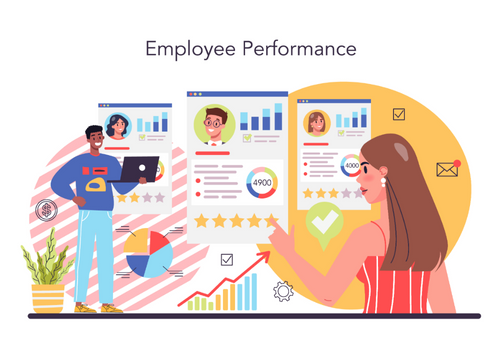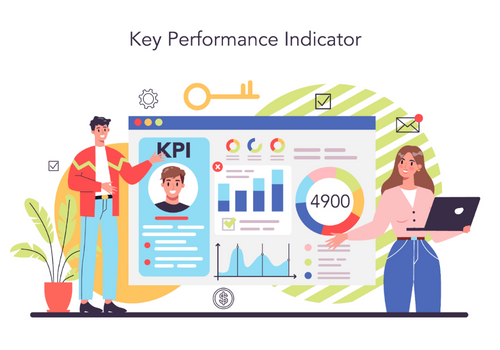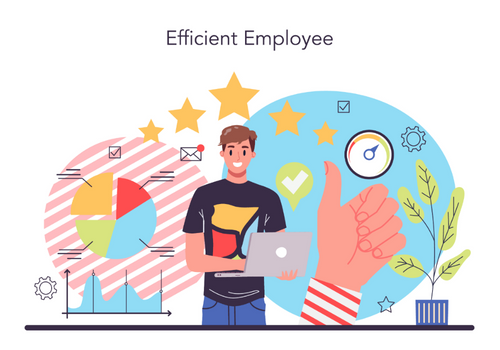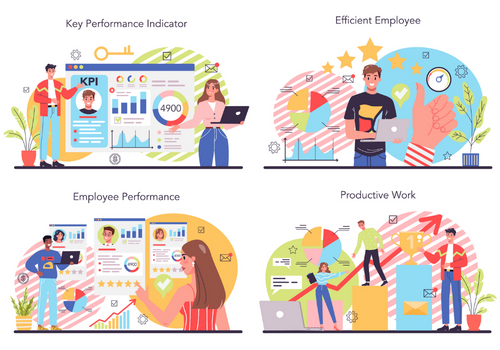Data analysis has long been a part of business decision-making, primarily among sales departments and executives.
They use data sets to gain actionable insights on supply costs, customer retention, future business, and sales revenue to improve efficiency, productivity, & profitability.
In fact, organizations that use big data become more profitable by 8{194d821e0dc8d10be69d2d4a52551aeafc2dee4011c6c9faa8f16ae7103581f6} and see a 10{194d821e0dc8d10be69d2d4a52551aeafc2dee4011c6c9faa8f16ae7103581f6} reduction in cost – and that’s not limited to analyzing sales and revenue data sets.
Did you know that you can also analyze HR data (also called people data & people analytics) for better performance management, increased employee engagement, and improved employee retention?
More companies are beginning to realize this, and they’re using HR analytics software to help make sense of all their employee data.

After all, the chances are high that you already have plenty of data sources on your employees in Excel spreadsheets, paper files, and HRIS systems.
HR analytics tools enable you to centralize all this data & analyze it using a variety of different data visualization methods. By visualizing your workforce data using charts, graphs, and tables – you’ll be able to make more informed decisions on labor needs, workforce costs, performance, and attendance.
How do you know which HR analytics tools to use?
Finding the right platform can be a bit tricky, as there are countless tools out there – all varying in quality and capability.
That’s why I’ve made it easy for you by compiling the top 10 HR analytics tools from around the web, as well as highlighting their key features.
#1: Visier
Best for: People Analytics & Customizable Reports
 First up is Visier, an AI-powered HR analytics tool with some truly robust features. In particular, it excels in predictive analytics for employees, such as how long an employee will stay with the company.
First up is Visier, an AI-powered HR analytics tool with some truly robust features. In particular, it excels in predictive analytics for employees, such as how long an employee will stay with the company.
How can it do that?
Visier can look at HR data, payroll, and the last two years of an employee’s history to determine when they’re most likely to resign.
This feature is useful for identifying the employees most likely to leave the company, which managers can then focus their efforts on – reducing employee turnover & improving retention.
Its predictive analytics can also create employee roadmaps that provide potential paths for advancement. Visier uses the employee’s job history and experience to map out the most efficient and realistic path to develop their career.
Are you having trouble deciding which employee to promote?
Visier can help with that, too, as its predictive capabilities will help you identify the most qualified candidates for promotions.
The user interface is relatively straightforward and easy to understand, and the company provides plenty of onboarding tools – such as a knowledge library, eLearning courses, and customer service agents ready to answer your questions.
A noticeable perk is the platform’s ability to create custom reports in addition to the standard report templates, which provides a great deal of flexibility for HR teams.
Pros:
Cons:
-
Pricing options could be better
-
The mobile app needs work
-
No storage features (no secure backup of internal data)
#2: Leapsome
Best for: Employee Engagement Forecasting
Next up is Leapsome, a versatile HR analytics tool that’s perfect for organizations of all sizes. With it, your HR team can track employee growth, engagement, performance, and more.
In particular, Leapsome excels at measuring employee engagement due to its engagement survey templates, which are constructed and verified by HR experts. You control whether each survey is identified or anonymous, and you have the ability to create custom questions.
Leapsome will store all employee feedback you receive, and you can reuse it for future development.
The platform boasts many integrations, including HR department staples like Slack, Teams, Calendar, Jira, and HRIS systems. As a result, you can streamline your workflows and import employee data from all your HR systems.
You can use Leapsome to hold more productive team meetings and one-on-one coaching sessions, as it integrates with any calendar app. You also have the ability to take notes, assign action items, and collaborate on a shared agenda.
There are also tools for performance reviews, development frameworks, employee onboarding, goal-setting, and OKRs management – making Leapsome a truly diverse HR analytics solution.
Pros:
Cons:
#3: DreamTeam
Best for: Recruitment KPI Tracking
 DreamTeam is an HR analytics platform that’s primarily focused on recruiting. It provides users the ability to create customized HR dashboards containing imported data from your applicant tracking system (ATS).
DreamTeam is an HR analytics platform that’s primarily focused on recruiting. It provides users the ability to create customized HR dashboards containing imported data from your applicant tracking system (ATS).
If you don’t want to create a custom dashboard from scratch, there are plenty of templates available that will get the job done.
Arguably its most valuable feature is the ability to track essential KPIs for recruiters, such as time to hire, time to fill, hires made, and other HR metrics that showcase the efforts of recruiters.
Being able to view these KPIs in one central location greatly simplifies a task that would take hours to complete manually, and it does so in real time. As a result, implementing DreamTeam can improve the efficiency and productivity of your recruitment team, which is certainly a plus.
Another major area where DreamTeam excels is applicant retention. Its applicant withdrawal rate tool allows users to not only view how many applicants withdrew but also see the reasons why the applicants chose to withdraw.
That will make it easy for your HR team to realize where they’re losing the most candidates, which can help you hold on to the most attractive applicants.
There’s also the ability to track time-to-hire rates, which will let you know if you’re wasting too much time between interviews and the hiring process.
Last but not least, DreamTeam includes helpful candidate surveys that aid in the recruitment process. While plenty of HR platforms offer employee surveys, candidate surveys are harder to come by, and DreamTeam makes them completely customizable.
Pros:
-
An excellent platform for recruiters
-
In-depth recruitment KPI tracking
-
Candidate surveys & applicant withdrawal rate tools
Cons:
#4: Crunchr
Best for: Centralizing All Employee Data
One of the primary reasons HR professionals seek analytics tools is the ability to centralize all their employee data in one spot to make data analytics a breeze.
Out of all the tools available, Crunchr is the best HR analytics tool for centralizing data, as it enables you to include data from ALL your HR systems, including:
This makes Crunchr an all-in-one solution for analyzing your people’s data. Like DreamTeam, there are a healthy number of pre-built dashboards, and you also have the ability to create custom dashboards from scratch.
Another unique feature is Crunchr’s Workforce Planning Tool, which enables you to create detailed recruitment & HR strategies. You can transform your business initiatives into a detailed agenda complete with measurable goals & milestones.
Thanks to Crunchr’s intuitive AI wizards, you’ll be able to instantly know how many and what type of employees your company needs to thrive. The Workforce Planning Tool is in sync with your employee data and HR dashboards, so the data it uses is accurate and up to date.
Another perk is that the tool can directly communicate with other departments in your organization, such as Finance and Sales, which makes collaborating on business strategies effortless.
Pros:
-
Flawless data centralization from all HR data sources
-
Excellent workforce management system
-
User-friendly interface and dashboards
Cons:
#5: Deel
Best for: Analyzing Distributed Workforces
Do you hire employees from around the globe?
If so, you’ll definitely want to check out Deel, an employment platform that allows you to hire employees from 150+ countries.
The best part is you can hire anyone as an employee or contractor without having to deal with cumbersome local laws, tax systems, or complicated payroll. You can also manage & analyze your invoices, contracts, and equipment, which makes it a powerful analytical tool.
Deel has an attractive UI that’s friendly to new users, and the developers continue to update the tool. Recently, Deel received a Slack integration that enables users to create organizational charts, self-service PTO systems, and more.
The platform also integrates with Open API, NetSuite, Xero, Ashby, and Greenhouse, and you can easily import and export data from them all.
If you’re savvy with Open API, you can build a custom interface that operates on top of Deel.
Overall, Deel is the best HR analytics tool for global teams.
Pros:
-
Makes hiring easy for global teams
-
Integrates with lots of platforms
-
User-friendly interface
-
A free version for businesses with up to 200 people
Cons:
#6: Paycor
Best for: Employee Retention Initiatives
 Paycor is an HR analytics tool that gathers data from your payroll, attendance, and employee benefits to provide insights on workforce trends.
Paycor is an HR analytics tool that gathers data from your payroll, attendance, and employee benefits to provide insights on workforce trends.
These trends can aid in your HR decision-making, such as identifying training & development needs for your employees.
The platform also has many helpful visualization tools to help users identify workplace trends, monitor employee performance, and even share data with colleagues in a format that’s easy to understand.
Something unique Paycor has going for it is its ability to show you how you’re stacking up to your competitors.
You’ll be able to view how your turnover rate compares to others, as well as productivity, retention, and engagement – which can help you gain a competitive edge.
With Paycor, you can make more informed decisions regarding your employee’s career paths and compensation packages, thanks to the platform’s detailed HR metrics.
The thing that Paycor does best is its predictive analytics surrounding employee retention and turnover. It lets you know the probability and severity of turnover you’re likely to see within the next 12 months with a high degree of accuracy.
How does it do that?
Paycor’s predictive analytics model uses a combination of factors to predict how likely an employee is to leave, including job satisfaction, performance reviews, tenure, and more.
The platform integrates with many tools, such as:
-
HireTech
-
Tapcheck
-
Instant Pay
-
FMLA
-
Points North
-
Sterling
-
Wageworks
-
Ignite
-
Many others
Pros:
-
Top-tier predictive analytics for employee retention
-
Excellent customer service
-
The ability to customize reports
Cons:
#7: Tableau
Best for: Tracking Diversity Data
Tableau is one of the best HR analytics tools for universities due to its inclusion of diversity data.
Being able to track diversity data can also help HR leaders identify gaps in their workforce, which can help them become more inclusive & diverse.
Besides diversity, you can use Tableau to track and analyze data on compensation, recruiting efficiency, employee lifecycle, and employee experience, among others.
With a strong focus on the business intelligence side of HR, Tableau boasts many in-depth HR dashboards for everything from employee turnover to feedback on surveys and more. Despite its plethora of advanced features, a noticeable downside to Tableau is its steep learning curve.
While you don’t need to be a seasoned data scientist to use the program, it will take lots of training sessions & onboarding tools to get the hang of things at first.
Pros:
-
A large collection of data visualization tools
-
The ability to track diversity data
-
Numerous dashboards for HR management
Cons:
#8: Papaya Global
Best for: Tracking Employee Equity
Another valuable payroll tool, Papaya Global is a SaaS HR analytics tool that has excellent features for tracking the gender, pay, and age equity at your organization.
It’s also a global solution that supports automated cross-border payments in over 160 countries. Whether you work with employee payroll, contractors, or EoR, Papaya Global supports them all.
So if you’ve been struggling to pay your global team online, Papaya Global is the perfect tool to add to your arsenal.
You’ll be able to set up automated payments for everyone and then let it run on autopilot, which will free up a lot of your time. The platform’s global payment network guarantees payment within 72 hours, and they pay workers in their desired currency, which is a definite plus.
Papaya Global is an excellent platform for uncovering valuable insights into your workforce spending, and it integrates with plenty of other workforce management tools.
For instance, its data analytics tools may lead you to discover that you’ve been overspending due to overtime or hiring too many employees.
Retention-wise, Papaya Global’s employee metrics will help you understand why certain employees chose to leave, which can help you hold onto top talent. You also have the ability to learn more about your team, including viewing their geographic location, cost center, past experience, and more.
The platform makes it effortless to see where your organization stands in terms of equity for gender, age, race, and pay.
Pros:
-
Automated cross-border payments
-
Excellent tools for analyzing workforce spending
-
Easy to view employee equity
-
Responsive customer service
Cons:
#9: ChartHop
Best for: Visualizing People Data
 ChartHop is one of the best HR analytics tools for visualizing workforce data in an appealing & straightforward way. While still relatively new, ChartHop has quickly become one of the most popular human resource management tools due to its highly visual format and ease of use.
ChartHop is one of the best HR analytics tools for visualizing workforce data in an appealing & straightforward way. While still relatively new, ChartHop has quickly become one of the most popular human resource management tools due to its highly visual format and ease of use.
Managers will appreciate the one-on-one feedback forms ChartHop provides, which they can use to obtain useful feedback from employees.
You can develop old data and metrics into detailed charts & graphs that you use to inform decisions surrounding employee engagement, retention, recruitment, and more. The platform features real-time reporting and performance evaluation tools that you can use to boost the efficiency of your organization.
ChartHop also has customizable employee surveys related to engagement, performance, and turnover. As a result, ChartHop can help you analyze old data and gather new data for analysis.
Lastly, ChartHop is another tool that’s useful for improving diversity, equity, and inclusion (DEI). The platform has DEI dashboards that allow you to view & identify gaps in the diversity and inclusiveness of your workplace.
Pros:
Cons:
-
UI needs updating
-
Lack of API integration
-
Lack of onboarding tools
#10: IBM Workforce Planning
Best for: Future Forecasting
If you need a tool to help with workforce forecasting, you can’t beat IBM’s machine learning-powered Workforce Planning platform.
There are many tools for workforce planning and forecasting, and its visualization tools are straightforward and simple to understand. It primarily works off past data trends, but you do have the option of collecting data sets from multiple sources for analysis.
This platform undoubtedly has the strongest AI-powered tools for forecasting & data analysis, so you shouldn’t pass up its free trial if you’re in need of talent management software.
Pros:
Cons:
Final Thoughts: Top 10 HR Analytics Tools for 2023
HR analytics tools are the best way for companies to improve their decision-making surrounding recruitment, engagement, attrition, and more.
Being able to centralize your data sources and analyze crucial HR metrics are invaluable tools for any organization, which is why these tools are worth the investment.
Did I forget to mention your favorite HR analytics tool? Let me know in the comments below.